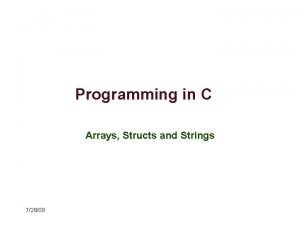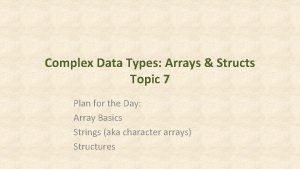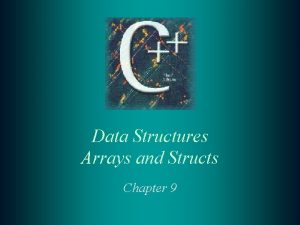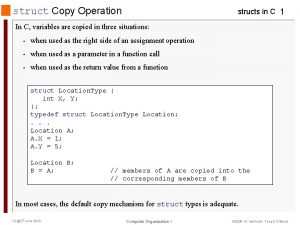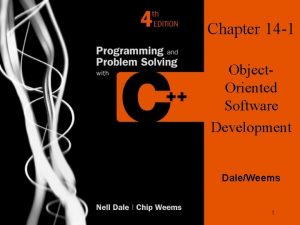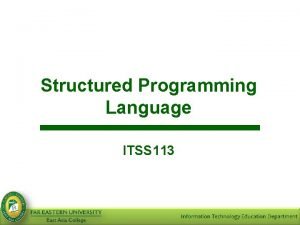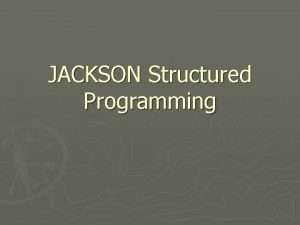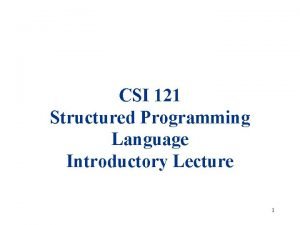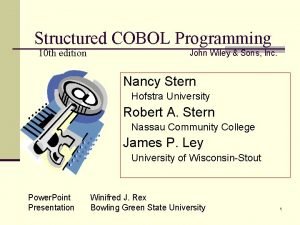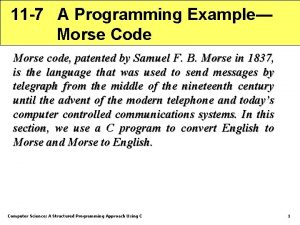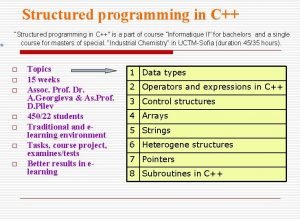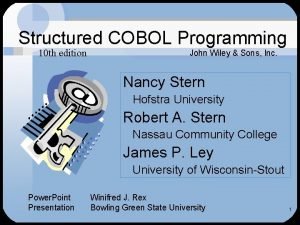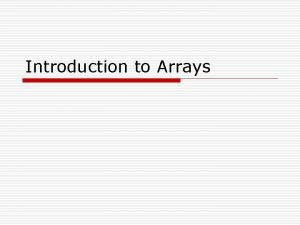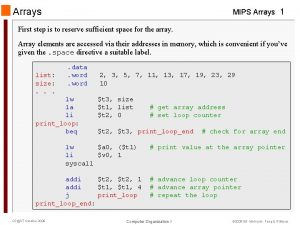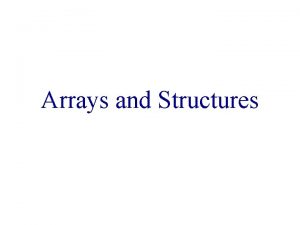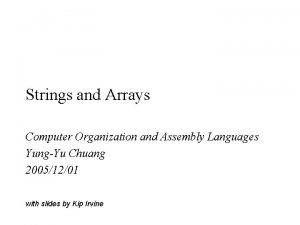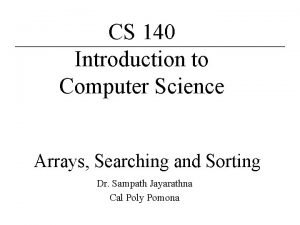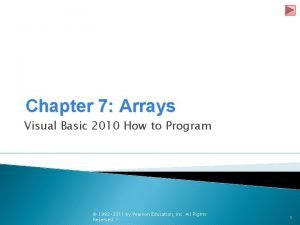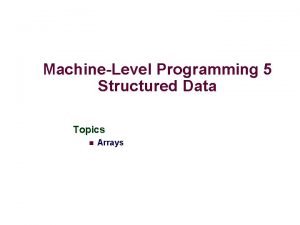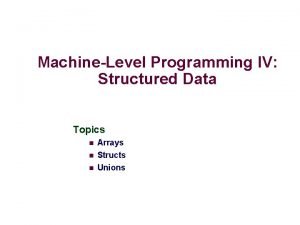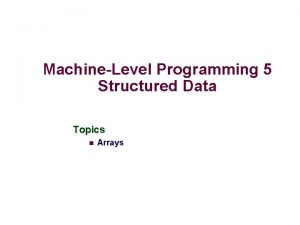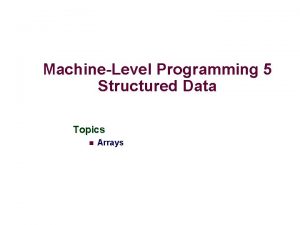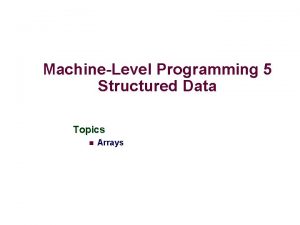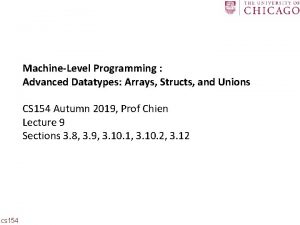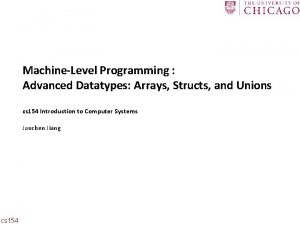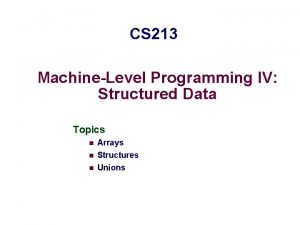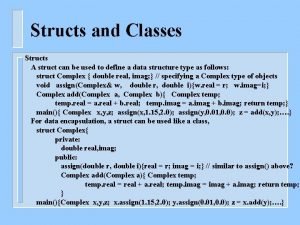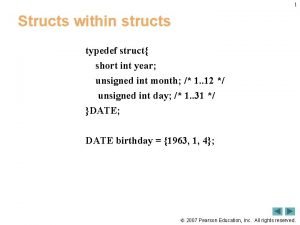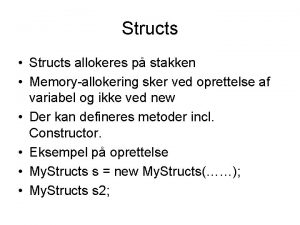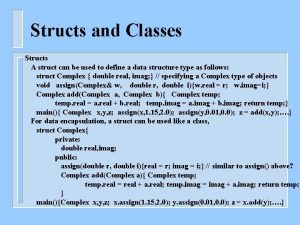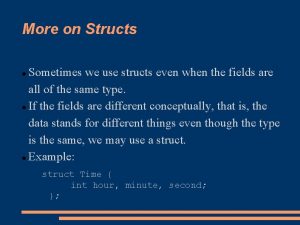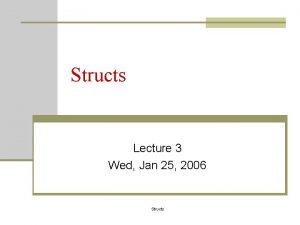MachineLevel Programming IV Structured Data Topics Arrays Structs


![Array Allocation Basic Principle T A[L]; Array of data type T and length L Array Allocation Basic Principle T A[L]; Array of data type T and length L](https://slidetodoc.com/presentation_image_h/23f685f66b43a9de1f46efcb8a1f5185/image-3.jpg)
![Array Access Basic Principle T A[L]; Array of data type T and length L Array Access Basic Principle T A[L]; Array of data type T and length L](https://slidetodoc.com/presentation_image_h/23f685f66b43a9de1f46efcb8a1f5185/image-4.jpg)
![Array Example typedef int zip_dig[5]; zip_dig cmu = { 1, 5, 2, 1, 3 Array Example typedef int zip_dig[5]; zip_dig cmu = { 1, 5, 2, 1, 3](https://slidetodoc.com/presentation_image_h/23f685f66b43a9de1f46efcb8a1f5185/image-5.jpg)




![Nested Array Example #define PCOUNT 4 zip_dig pgh[PCOUNT] = {{1, 5, 2, 0, 6}, Nested Array Example #define PCOUNT 4 zip_dig pgh[PCOUNT] = {{1, 5, 2, 0, 6},](https://slidetodoc.com/presentation_image_h/23f685f66b43a9de1f46efcb8a1f5185/image-10.jpg)
![Nested Array Allocation Declaration T A[R][C]; A[0][0] Array of data type T R rows, Nested Array Allocation Declaration T A[R][C]; A[0][0] Array of data type T R rows,](https://slidetodoc.com/presentation_image_h/23f685f66b43a9de1f46efcb8a1f5185/image-11.jpg)
![Nested Array Row Access Row Vectors A[i] is array of C elements Each element Nested Array Row Access Row Vectors A[i] is array of C elements Each element](https://slidetodoc.com/presentation_image_h/23f685f66b43a9de1f46efcb8a1f5185/image-12.jpg)
![Nested Array Row Access Code int *get_pgh_zip(int index) { return pgh[index]; } Row Vector Nested Array Row Access Code int *get_pgh_zip(int index) { return pgh[index]; } Row Vector](https://slidetodoc.com/presentation_image_h/23f685f66b43a9de1f46efcb8a1f5185/image-13.jpg)
![Nested Array Element Access Array Elements A [i] [j] A[i][j] is element of type Nested Array Element Access Array Elements A [i] [j] A[i][j] is element of type](https://slidetodoc.com/presentation_image_h/23f685f66b43a9de1f46efcb8a1f5185/image-14.jpg)
![Nested Array Element Access Code Array Elements pgh[index][dig] is int Address: pgh + 20*index Nested Array Element Access Code Array Elements pgh[index][dig] is int Address: pgh + 20*index](https://slidetodoc.com/presentation_image_h/23f685f66b43a9de1f46efcb8a1f5185/image-15.jpg)
![Strange Referencing Examples zip_dig pgh[4]; 1 5 2 0 6 1 5 2 1 Strange Referencing Examples zip_dig pgh[4]; 1 5 2 0 6 1 5 2 1](https://slidetodoc.com/presentation_image_h/23f685f66b43a9de1f46efcb8a1f5185/image-16.jpg)




![Using Nested Arrays #define N 16 typedef int fix_matrix[N][N]; Strengths C compiler handles doubly Using Nested Arrays #define N 16 typedef int fix_matrix[N][N]; Strengths C compiler handles doubly](https://slidetodoc.com/presentation_image_h/23f685f66b43a9de1f46efcb8a1f5185/image-21.jpg)

![Generating Pointer to Struct. Member r struct rec { int i; int a[3]; int Generating Pointer to Struct. Member r struct rec { int i; int a[3]; int](https://slidetodoc.com/presentation_image_h/23f685f66b43a9de1f46efcb8a1f5185/image-23.jpg)
![Structure Referencing (Cont. ) C Code struct rec { int i; int a[3]; int Structure Referencing (Cont. ) C Code struct rec { int i; int a[3]; int](https://slidetodoc.com/presentation_image_h/23f685f66b43a9de1f46efcb8a1f5185/image-24.jpg)



![Linux vs. Windows struct S 1 { char c; int i[2]; double v; } Linux vs. Windows struct S 1 { char c; int i[2]; double v; }](https://slidetodoc.com/presentation_image_h/23f685f66b43a9de1f46efcb8a1f5185/image-28.jpg)
![Overall Alignment Requirement struct S 2 { double x; int i[2]; char c; } Overall Alignment Requirement struct S 2 { double x; int i[2]; char c; }](https://slidetodoc.com/presentation_image_h/23f685f66b43a9de1f46efcb8a1f5185/image-29.jpg)





- Slides: 34

Machine-Level Programming IV: Structured Data Topics Arrays Structs Unions

Basic Data Types Integral Stored & operated on in general registers Signed vs. unsigned depends on instructions used Intel GAS byte b word w double word Bytes 1 2 l C [unsigned] char [unsigned] short 4 [unsigned] int Floating Point Stored & operated on in floating point registers Intel GAS Single s Double l Extended – 2 – Bytes 4 8 t C float double 10/12 long double
![Array Allocation Basic Principle T AL Array of data type T and length L Array Allocation Basic Principle T A[L]; Array of data type T and length L](https://slidetodoc.com/presentation_image_h/23f685f66b43a9de1f46efcb8a1f5185/image-3.jpg)
Array Allocation Basic Principle T A[L]; Array of data type T and length L Contiguously allocated region of L * sizeof(T) bytes char string[12]; x x + 12 int val[5]; x double a[4]; x x + 4 x + 8 x + 16 char *p[3]; x – 3 – x + 4 x + 8 x + 12 x + 16 x + 24 x + 20 x + 32
![Array Access Basic Principle T AL Array of data type T and length L Array Access Basic Principle T A[L]; Array of data type T and length L](https://slidetodoc.com/presentation_image_h/23f685f66b43a9de1f46efcb8a1f5185/image-4.jpg)
Array Access Basic Principle T A[L]; Array of data type T and length L Identifier A can be used as a pointer to array element 0 int val[5]; 1 x 5 x + 4 Reference Type Value val[4] int val int * x val+1 int * x + 4 &val[2] int * x + 8 val[5] int *(val+1) int – 4 – val + i 3 ? ? 5 int * x + 4 i 2 x + 8 1 3 x + 12 x + 16 x + 20
![Array Example typedef int zipdig5 zipdig cmu 1 5 2 1 3 Array Example typedef int zip_dig[5]; zip_dig cmu = { 1, 5, 2, 1, 3](https://slidetodoc.com/presentation_image_h/23f685f66b43a9de1f46efcb8a1f5185/image-5.jpg)
Array Example typedef int zip_dig[5]; zip_dig cmu = { 1, 5, 2, 1, 3 }; zip_dig mit = { 0, 2, 1, 3, 9 }; zip_dig ucb = { 9, 4, 7, 2, 0 }; zip_dig cmu; 1 16 zip_dig mit; 5 20 0 36 zip_dig ucb; 24 2 40 9 56 2 28 1 44 4 60 1 32 3 48 7 64 3 9 52 2 68 36 56 0 72 76 Notes – 5 – Declaration “zip_dig cmu” equivalent to “int cmu[5]” Example arrays were allocated in successive 20 byte blocks Not guaranteed to happen in general

Array Accessing Example Computation Register %edx contains starting int get_digit (zip_dig z, int dig) address of array { Register %eax contains array index Desired digit at 4*%eax + %edx Use memory reference (%edx, %eax, 4) return z[dig]; } Memory Reference Code # %edx = z # %eax = dig movl (%edx, %eax, 4), %eax # z[dig] – 6 –

Referencing Examples zip_dig cmu; 1 16 zip_dig mit; 5 20 0 36 zip_dig ucb; 24 2 1 28 1 40 9 56 2 44 4 64 32 3 48 7 60 3 36 9 52 2 68 56 0 72 Code Does Not Do Any Bounds Checking! Reference Address Value Guaranteed? mit[3] 36 + 4* 3 = 48 3 mit[5] 36 + 4* 5 = 56 9 mit[-1] 36 + 4*-1 = 32 3 cmu[15] 16 + 4*15 = 76 ? ? – 7 – Yes No No No Out of range behavior implementation-dependent No guaranteed relative allocation of different arrays 76

Array Loop Example Original Source Transformed Version As generated by GCC Eliminate loop variable i Convert array code to pointer code Express in do-while form No need to test at entrance – 8 – int zd 2 int(zip_dig z) { int i; int zi = 0; for (i = 0; i < 5; i++) { zi = 10 * zi + z[i]; } return zi; } int zd 2 int(zip_dig z) { int zi = 0; int *zend = z + 4; do { zi = 10 * zi + *z; z++; } while(z <= zend); return zi; }

Array Loop Implementation Registers %ecx %eax %ebx z zi zend Computations 10*zi + *z implemented as *z + 2*(zi+4*zi) z++ increments by 4 – 9 – # %ecx = z xorl %eax, %eax leal 16(%ecx), %ebx. L 59: leal (%eax, 4), %edx movl (%ecx), %eax addl $4, %ecx leal (%eax, %edx, 2), %eax cmpl %ebx, %ecx jle. L 59 int zd 2 int(zip_dig z) { int zi = 0; int *zend = z + 4; do { zi = 10 * zi + *z; z++; } while(z <= zend); return zi; } # zi = 0 # zend = z+4 # 5*zi # *z # z++ # zi = *z + 2*(5*zi) # z : zend # if <= goto loop
![Nested Array Example define PCOUNT 4 zipdig pghPCOUNT 1 5 2 0 6 Nested Array Example #define PCOUNT 4 zip_dig pgh[PCOUNT] = {{1, 5, 2, 0, 6},](https://slidetodoc.com/presentation_image_h/23f685f66b43a9de1f46efcb8a1f5185/image-10.jpg)
Nested Array Example #define PCOUNT 4 zip_dig pgh[PCOUNT] = {{1, 5, 2, 0, 6}, {1, 5, 2, 1, 3 }, {1, 5, 2, 1, 7 }, {1, 5, 2, 2, 1 }}; zip_dig pgh[4]; 1 5 2 0 6 1 5 2 1 3 1 5 2 1 7 1 5 2 2 1 76 96 116 136 Declaration “zip_dig pgh[4]” equivalent to “int pgh[4][5]” Variable pgh denotes array of 4 elements » Allocated contiguously Each element is an array of 5 int’s » Allocated contiguously – 10 – 156 “Row-Major” ordering of all elements guaranteed
![Nested Array Allocation Declaration T ARC A00 Array of data type T R rows Nested Array Allocation Declaration T A[R][C]; A[0][0] Array of data type T R rows,](https://slidetodoc.com/presentation_image_h/23f685f66b43a9de1f46efcb8a1f5185/image-11.jpg)
Nested Array Allocation Declaration T A[R][C]; A[0][0] Array of data type T R rows, C columns Type T element requires K bytes • • • A[0][C-1] • • • A[R-1][0] • • • A[R-1][C-1] Array Size R * C * K bytes Arrangement Row-Major Ordering int A[R][C]; A A [0] • • • [0] [1] • • • [1] [0] [C-1] 4*R*C Bytes – 11 – • • • A A [R-1] • • • [R-1] [0] [C-1]
![Nested Array Row Access Row Vectors Ai is array of C elements Each element Nested Array Row Access Row Vectors A[i] is array of C elements Each element](https://slidetodoc.com/presentation_image_h/23f685f66b43a9de1f46efcb8a1f5185/image-12.jpg)
Nested Array Row Access Row Vectors A[i] is array of C elements Each element of type T Starting address A + i * C * K int A[R][C]; A[0] A – 12 – • • • A[i] A [0] • • • [C-1] A [i] [0] • • • A+i*C*4 A[R-1] A A [i] • • • [R-1] [C-1] [0] • • • A+(R-1)*C*4 A [R-1] [C-1]
![Nested Array Row Access Code int getpghzipint index return pghindex Row Vector Nested Array Row Access Code int *get_pgh_zip(int index) { return pgh[index]; } Row Vector](https://slidetodoc.com/presentation_image_h/23f685f66b43a9de1f46efcb8a1f5185/image-13.jpg)
Nested Array Row Access Code int *get_pgh_zip(int index) { return pgh[index]; } Row Vector pgh[index] is array of 5 int’s Starting address pgh+20*index Code Computes and returns address Compute as pgh + 4*(index+4*index) # %eax = index leal (%eax, 4), %eax leal pgh(, %eax, 4), %eax – 13 – # 5 * index # pgh + (20 * index)
![Nested Array Element Access Array Elements A i j Aij is element of type Nested Array Element Access Array Elements A [i] [j] A[i][j] is element of type](https://slidetodoc.com/presentation_image_h/23f685f66b43a9de1f46efcb8a1f5185/image-14.jpg)
Nested Array Element Access Array Elements A [i] [j] A[i][j] is element of type T Address A + (i * C + j) * K int A[R][C]; A[0] A • • • A[R-1] A[i] A [0] • • • [C-1] • • • A [i] [j] • • • A+i*C*4 A+(i*C+j)*4 – 14 – A • • • [R-1] [0] • • • A+(R-1)*C*4 A [R-1] [C-1]
![Nested Array Element Access Code Array Elements pghindexdig is int Address pgh 20index Nested Array Element Access Code Array Elements pgh[index][dig] is int Address: pgh + 20*index](https://slidetodoc.com/presentation_image_h/23f685f66b43a9de1f46efcb8a1f5185/image-15.jpg)
Nested Array Element Access Code Array Elements pgh[index][dig] is int Address: pgh + 20*index + 4*dig Code int get_pgh_digit (int index, int dig) { return pgh[index][dig]; } Computes address pgh + 4*dig + 4*(index+4*index) movl performs memory reference # %ecx = dig # %eax = index leal 0(, %ecx, 4), %edx leal (%eax, 4), %eax movl pgh(%edx, %eax, 4), %eax – 15 – # 4*dig # 5*index # *(pgh + 4*dig + 20*index)
![Strange Referencing Examples zipdig pgh4 1 5 2 0 6 1 5 2 1 Strange Referencing Examples zip_dig pgh[4]; 1 5 2 0 6 1 5 2 1](https://slidetodoc.com/presentation_image_h/23f685f66b43a9de1f46efcb8a1f5185/image-16.jpg)
Strange Referencing Examples zip_dig pgh[4]; 1 5 2 0 6 1 5 2 1 3 1 5 2 1 7 1 5 2 2 1 76 96 Reference Address 116 136 Value Guaranteed? pgh[3][3] 76+20*3+4*3 = 148 2 Yes pgh[2][5] 76+20*2+4*5 = 136 1 Yes pgh[2][-1] 76+20*2+4*-1 = 112 3 Yes pgh[4][-1] 76+20*4+4*-1 = 152 1 Yes pgh[0][19] 76+20*0+4*19 = 152 1 Yes pgh[0][-1] 76+20*0+4*-1 = 72 ? ? No Code does not do any bounds checking Ordering of elements within array guaranteed – 16 – 156

Multi-Level Array Example Variable univ denotes array of 3 elements Each element is a pointer 4 bytes Each pointer points to array of int’s zip_dig cmu = { 1, 5, 2, 1, 3 }; zip_dig mit = { 0, 2, 1, 3, 9 }; zip_dig ucb = { 9, 4, 7, 2, 0 }; #define UCOUNT 3 int *univ[UCOUNT] = {mit, cmu, ucb}; cmu univ 160 36 164 16 168 56 mit 1 16 20 0 ucb 36 56 – 17 – 5 2 24 2 40 9 28 1 44 4 60 1 32 3 48 7 64 3 9 52 2 68 36 56 0 72 76

Element Access in Multi-Level Array Computation int get_univ_digit (int index, int dig) { return univ[index][dig]; } Element access Mem[univ+4*index]+4*dig] Must do two memory reads First get pointer to row array Then access element within array # %ecx = index # %eax = dig leal 0(, %ecx, 4), %edx movl univ(%edx), %edx movl (%edx, %eax, 4), %eax – 18 – # 4*index # Mem[univ+4*index] # Mem[. . . +4*dig]

Array Element Accesses Similar C references Nested Array int get_pgh_digit (int index, int dig) { return pgh[index][dig]; } Element at Mem[pgh+20*index+4*dig] – 19 – Different address computation Multi-Level Array int get_univ_digit (int index, int dig) { return univ[index][dig]; } Element at Mem[univ+4*index]+4*dig]

Strange Referencing Examples cmu univ 160 36 164 16 168 56 mit 1 16 5 20 0 ucb 36 56 Reference Address 40 9 Value 2 univ[1][5] 16+4*5 = 36 0 univ[2][-1] 56+4*-1 = 52 9 univ[3][-1] ? ? univ[1][12] 16+4*12 = 64 7 28 44 60 1 1 4 56+4*3 = 68 – 20 – 24 2 univ[2][3] 2 32 3 48 7 64 3 36 9 52 2 68 56 0 72 76 Guaranteed? Code does not do any bounds checking Ordering of elements in different arrays not guaranteed Yes No No
![Using Nested Arrays define N 16 typedef int fixmatrixNN Strengths C compiler handles doubly Using Nested Arrays #define N 16 typedef int fix_matrix[N][N]; Strengths C compiler handles doubly](https://slidetodoc.com/presentation_image_h/23f685f66b43a9de1f46efcb8a1f5185/image-21.jpg)
Using Nested Arrays #define N 16 typedef int fix_matrix[N][N]; Strengths C compiler handles doubly subscripted arrays Generates very efficient code Avoids multiply in index computation Limitation Only works if have fixed array size (*, k) (i, *) Row-wise A Column-wise – 21 – B /* Compute element i, k of fixed matrix product */ int fix_prod_ele (fix_matrix a, fix_matrix b, int i, int k) { int j; int result = 0; for (j = 0; j < N; j++) result += a[i][j]*b[j][k]; return result; }

Structures Concept Contiguously-allocated region of memory Refer to members within structure by names Members may be of different types struct rec { int i; int a[3]; int *p; }; Memory Layout i 0 a 4 p 16 20 Accessing Structure Member void set_i(struct rec *r, int val) { r->i = val; } – 25 – Assembly # %eax = val # %edx = r movl %eax, (%edx) # Mem[r] = val
![Generating Pointer to Struct Member r struct rec int i int a3 int Generating Pointer to Struct. Member r struct rec { int i; int a[3]; int](https://slidetodoc.com/presentation_image_h/23f685f66b43a9de1f46efcb8a1f5185/image-23.jpg)
Generating Pointer to Struct. Member r struct rec { int i; int a[3]; int *p; }; Generating Pointer to Array Element Offset of each structure member determined at compile time # %ecx = idx # %edx = r leal 0(, %ecx, 4), %eax leal 4(%eax, %edx), %eax – 26 – i 0 a p 4 16 r + 4*idx int * find_a (struct rec *r, int idx) { return &r->a[idx]; } # 4*idx # r+4*idx+4
![Structure Referencing Cont C Code struct rec int i int a3 int Structure Referencing (Cont. ) C Code struct rec { int i; int a[3]; int](https://slidetodoc.com/presentation_image_h/23f685f66b43a9de1f46efcb8a1f5185/image-24.jpg)
Structure Referencing (Cont. ) C Code struct rec { int i; int a[3]; int *p; }; void set_p(struct rec *r) { r->p = &r->a[r->i]; } – 27 – i 0 a 4 i 0 p 16 a 4 16 Element i # %edx = r movl (%edx), %ecx # r->i leal 0(, %ecx, 4), %eax # 4*(r->i) leal 4(%edx, %eax), %eax # r+4+4*(r>i) movl %eax, 16(%edx) # Update r->p

Alignment Aligned Data Primitive data type requires K bytes Address must be multiple of K Required on some machines; advised on IA 32 treated differently by Linux and Windows! Motivation for Aligning Data Memory accessed by (aligned) double or quad-words Inefficient to load or store datum that spans quad word boundaries Virtual memory very tricky when datum spans 2 pages Compiler – 28 – Inserts gaps in structure to ensure correct alignment of fields

Specific Cases of Alignment Size of Primitive Data Type: 1 byte (e. g. , char) no restrictions on address 2 bytes (e. g. , short) lowest 1 bit of address must be 02 4 bytes (e. g. , int, float, char *, etc. ) lowest 2 bits of address must be 002 8 bytes (e. g. , double) Windows (and most other OS’s & instruction sets): » lowest 3 bits of address must be 0002 Linux: » lowest 2 bits of address must be 002 » i. e. , treated the same as a 4 -byte primitive data type 12 bytes (long double) Linux: » lowest 2 bits of address must be 002 » i. e. , treated the same as a 4 -byte primitive data type – 29 –

Satisfying Alignment with Structures Offsets Within Structure Must satisfy element’s alignment requirement Overall Structure Placement Each structure has alignment requirement K Largest alignment of any element struct S 1 { char c; int i[2]; double v; } *p; Initial address & structure length must be multiples of K Example (under Windows): K = 8, due to double element c p+0 i[0] p+4 Multiple of 8 – 30 – i[1] p+8 v p+16 p+24 Multiple of 8
![Linux vs Windows struct S 1 char c int i2 double v Linux vs. Windows struct S 1 { char c; int i[2]; double v; }](https://slidetodoc.com/presentation_image_h/23f685f66b43a9de1f46efcb8a1f5185/image-28.jpg)
Linux vs. Windows struct S 1 { char c; int i[2]; double v; } *p; Windows (including Cygwin): K = 8, due to double element c p+0 i[0] p+4 i[1] v p+8 p+16 Multiple of 4 Multiple of 8 p+24 Multiple of 8 Linux: K = 4; double treated like a 4 -byte data type c p+0 – 31 – i[0] p+4 Multiple of 4 i[1] p+8 v p+12 Multiple of 4 p+20 Multiple of 4
![Overall Alignment Requirement struct S 2 double x int i2 char c Overall Alignment Requirement struct S 2 { double x; int i[2]; char c; }](https://slidetodoc.com/presentation_image_h/23f685f66b43a9de1f46efcb8a1f5185/image-29.jpg)
Overall Alignment Requirement struct S 2 { double x; int i[2]; char c; } *p; p must be multiple of: 8 for Windows 4 for Linux x i[0] p+0 p+8 struct S 3 { float x[2]; int i[2]; char c; } *p; x[0] p+0 – 32 – p+12 c p+16 Windows: p+24 Linux: p+20 p must be multiple of 4 (in either OS) x[1] p+4 i[1] i[0] p+8 i[1] p+12 c p+16 p+20

Ordering Elements Within Structure struct S 4 { char c 1; double v; char c 2; int i; } *p; 10 bytes wasted space in Windows c 1 v p+0 p+8 struct S 5 { double v; char c 1; char c 2; int i; } *p; v p+0 – 33 – c 2 p+16 i p+20 2 bytes wasted space c 1 c 2 p+8 i p+12 p+16 p+24

Arrays of Structures Principle Allocated by repeating allocation for array type In general, may nest arrays & structures to arbitrary depth a[1]. i a[1]. v a+12 a+16 a[0] a+0 – 34 – a[1]. j a+20 a[1] a+12 struct S 6 { short i; float v; short j; } a[10]; a+24 • • • a[2] a+24 a+36

Accessing Element within Array Compute offset to start of structure Compute 12*i as 4*(i+2 i) struct S 6 { short i; float v; short j; } a[10]; Access element according to its offset within structure Offset by 8 Assembler gives displacement as a + 8 » Linker must set actual value short get_j(int idx) { return a[idx]. j; } a[0] a+0 a[i]. i a+12 i – 35 – # %eax = idx leal (%eax, 2), %eax # 3*idx movswl a+8(, %eax, 4), %eax • • • a[i] • • • a+12 i a[i]. v a[i]. j a+12 i+8

Satisfying Alignment within Structure Achieving Alignment Starting address of structure array must be multiple of worst-case alignment for any element a must be multiple of 4 Offset of element within structure must be multiple of element’s alignment requirement v’s offset of 4 is a multiple of 4 Overall size of structure must be multiple of worst-case alignment for any element struct S 6 { short i; float v; short j; } a[10]; Structure padded with unused space to be 12 bytes a[0] • • • a[i] a+12 i a+0 a[1]. i Multiple of 4 – 36 – a+12 i • • • a[1]. v a+12 i+4 Multiple of 4 a[1]. j

Union Allocation Principles Overlay union elements Allocate according to largest element Can only use one field at a time struct S 1 { char c; int i[2]; double v; } *sp; c sp+0 – 37 – sp+4 union U 1 { char c; int i[2]; double v; } *up; c i[0] up+0 i[1] v up+4 up+8 (Windows alignment) i[0] sp+8 i[1] v sp+16 sp+24
 C array of structs
C array of structs C array of pointers to structs
C array of pointers to structs Array of structs in c
Array of structs in c C sort array of structs
C sort array of structs How to copy a struct in c
How to copy a struct in c Disadvantages of unstructured interviews
Disadvantages of unstructured interviews Sa sd
Sa sd Array advantages and disadvantages
Array advantages and disadvantages Parallel arrays java
Parallel arrays java Convert unstructured to structured data
Convert unstructured to structured data Structured vs object oriented programming
Structured vs object oriented programming What is structured programming language
What is structured programming language Contoh program terstruktur
Contoh program terstruktur Percy jackson 1 cda
Percy jackson 1 cda What is structured programming language
What is structured programming language Structured cobol programming
Structured cobol programming Morse code programming
Morse code programming Control structure flow chart
Control structure flow chart Structured programming in c
Structured programming in c Structured cobol programming
Structured cobol programming Array of arrays c++
Array of arrays c++ Ragged array
Ragged array Partially filled arrays
Partially filled arrays Parallel arrays
Parallel arrays Why do we need arrays?
Why do we need arrays? Dynamic arrays and amortized analysis
Dynamic arrays and amortized analysis Arreglos en java ejemplos
Arreglos en java ejemplos Java arreglos bidimensionales
Java arreglos bidimensionales Array mips
Array mips Polynomial representation using arrays
Polynomial representation using arrays Arrays in arm assembly
Arrays in arm assembly Global arrays in c
Global arrays in c Computer science arrays
Computer science arrays Searching and sorting arrays in c++
Searching and sorting arrays in c++ Arrays visual basic
Arrays visual basic
